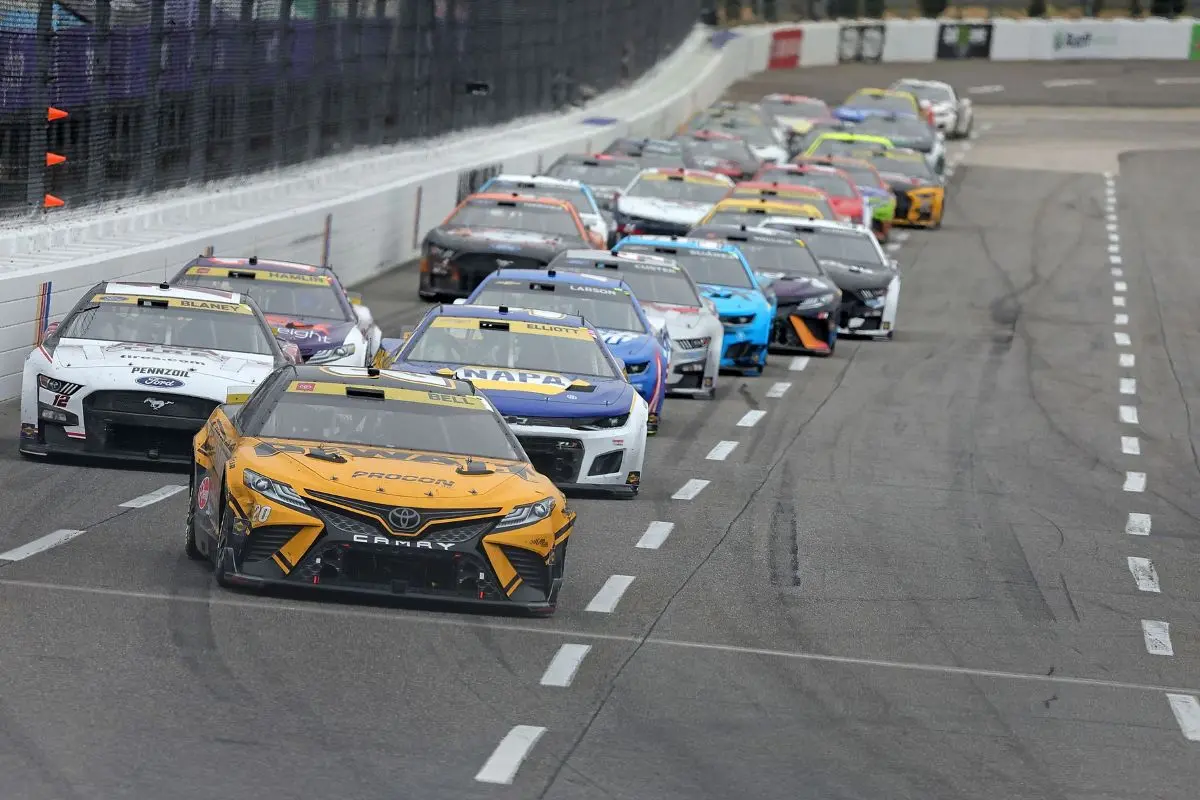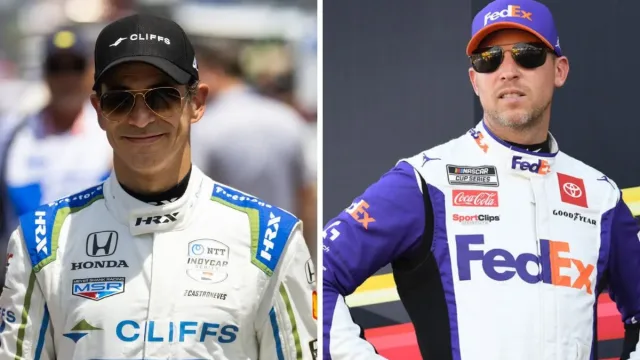Helio Castroneves secures big sponsorship deal while a well-known NASCAR driver faces a tough road ahead. With big companies shifting their focus, the sponsorship game is changing fast. Denny Hamlin, a seasoned competitor, now finds himself searching for new financial backing as FedEx steps away. But why do some drivers land major deals while others struggle? The answer isn’t simple, and a recent rule might be playing a big role. This shift is reshaping the future of the sport in unexpected ways.
Key Highlights
- Helio Castroneves secures a significant sponsorship deal, enhancing his competitive position in NASCAR.
- Denny Hamlin faces challenges after FedEx announces withdrawal of sponsorship by the end of the 2024 season.
- The OEP rule favors newcomers like Helio Castroneves, raising concerns about fairness for veteran drivers.
- Fragmented sponsorship landscape and economic uncertainties hinder Denny Hamlin’s efforts to secure new financial partners.
- NASCAR’s evolving brand strategies and technology shifts impact traditional drivers’ ability to attract sponsorship deals.
Denny Hamlin’s Sponsorship Struggles
Denny Hamlin, despite his success and status as a seasoned NASCAR driver, faces ongoing challenges in securing sponsorship deals that are essential for sustaining his racing career.
In NASCAR, the correlation between sponsorship and survival is undeniable, with drivers needing robust financial backing to remain competitive. Hamlin, known for his skill on the track, finds himself maneuvering a complex sponsorship landscape.
The industry’s shifting dynamics and increased competition for corporate partnerships intensify these challenges. High-profile sponsorships tend to gravitate towards fresh faces or those offering cross-promotional opportunities, often leaving even respected veterans like Hamlin in precarious positions.
While Hamlin’s on-track credentials are indisputable, the financial stability that sponsors bring is just as important.
The contrast between his situation and that of newcomers like Helio Castroneves, who secured a lucrative deal without similar battles, highlights the volatility and unpredictability inherent in NASCAR’s sponsorship framework.

Denny Hamlin’s Primary Sponsor Crisis
The sponsorship landscape in NASCAR is undergoing considerable transformation, and Denny Hamlin‘s recent predicament highlights the volatility of this environment.
As one of NASCAR’s most prominent figures, Hamlin now faces a challenge unprecedented in his career: the absence of a primary sponsor. After two decades of partnership, FedEx will no longer back him following the 2024 season, leaving Hamlin in search of new financial support. This development emphasizes the shifting dynamics within the sport, where long-standing relationships can suddenly unravel.
Hamlin’s situation is compounded by his vocal criticism of the NASCAR Owner-Driver Exception (OEP) rule, which grants certain drivers, like Helio Castroneves, automatic entry into important events.
“It just doesn’t sit right. It’s a guy like Helio, with all due respect, who hasn’t paid his dues in NASCAR, and yet he gets a free pass into the biggest race of the year?” – Denny Hamlin
Hamlin perceives this rule as inequitable, particularly given the effort required by traditional NASCAR drivers to earn their spots. The contrast of Castroneves’ seamless entry and Hamlin’s sponsorship woes adds a layer of complexity to the financial realities faced by NASCAR drivers today.
The Challenges of Securing Sponsorship in NASCAR
Navigating the shifting landscape of NASCAR sponsorships requires a subtle understanding of both the sport’s evolving economic conditions and the broader market forces at play. Established drivers like Denny Hamlin face considerable challenges in securing consistent sponsorship.
Despite his longstanding relationship with FedEx, Hamlin demonstrates the growing difficulty in attracting full-season sponsorships, a reality exacerbated by the decline in marketing opportunities. This decline is not just a reflection of Hamlin’s situation but indicates a broader trend affecting even the most successful drivers.
The challenges include:
- Sponsorship Fragmentation: Teams now often rely on multiple sponsors for a single season.
- Increased Competition: New entrants, such as crossover stars, add strain to secure deals.
- Evolving Brand Strategies: Companies seek more diversified marketing investments.
- Economic Factors: Broader economic uncertainties influence corporate sponsorship strategies.
- Technology and Media Shifts: Digital media shifts impact how brands engage with motorsport audiences.

The OEP Rule and Its Impact on NASCAR
Recognition within the domain of motorsport has always been a double-edged sword, as the OEP (Outstanding External Performance) Rule aims to improve NASCAR’s appeal by awarding stars from other racing disciplines, sparking debate about its implications.
This regulation, designed to attract broader audiences, raises questions of fairness and NASCAR experience, challenging the traditional merit-based entry. By potentially prioritizing external acclaim over internal achievement, the rule may inadvertently sideline seasoned NASCAR drivers, creating tension within the ranks.
Helio Castroneves’ impending participation, supported by notable sponsorship like Wendy’s, exemplifies this dynamic shift. As he enters with nothing to lose, established figures such as Denny Hamlin face heightened competition both on the track and within the sponsorship landscape.
The OEP Rule therefore serves as a catalyst, compelling NASCAR to balance between maintaining integrity and expanding its reach, a delicate task within the fiercely competitive world of motorsport.
The Bigger Picture: Sponsorship and Financial Struggles in NASCAR
While the OEP Rule reshapes competitive dynamics in NASCAR, the financial ecosystem surrounding the sport faces its own set of challenges. Denny Hamlin’s predicament highlights a broader trend affecting NASCAR: the dwindling flow of sponsorship dollars.
“In our sport, sponsorship dollars aren’t flowing like they used to. Teams are having to work harder than ever to get money and it’s not as simple as being a good driver.”
“It is tough out there. Sponsorship is hard to come by, and certainly, while it is such an important time in our sport, sponsorship dollars are not flowing like they used to.” – Denny Hamlin
Once a stable fixture with FedEx, Hamlin now confronts an uncertain future without a primary sponsor. His situation is not isolated; the financial strain is palpable across the sport. Teams are forced to make difficult decisions, as seen with Joe Gibbs Racing’s struggles following Mavis Tires’ exit.
- Denny Hamlin’s Sponsorship Loss: FedEx and Mavis Tires withdraw support.
- Broader Impact: Financial struggles are affecting teams and drivers.
- Historical Precedent: Kyle Busch faced a similar situation in 2022.
- Current Sponsorships: Partial deals with Sport Clips, Yahoo!, and King’s Hawaiian.
- Tactical Adaptation Needed: Teams must innovate to attract new sponsors.
 United Rentals 300 Entry List” width=”1200″ height=”800″ srcset=”https://slicksandsticks.com/wp-content/uploads/2025/02/2025-United-Rentals-300-Entry-List.webp 1200w, https://slicksandsticks.com/wp-content/uploads/2025/02/2025-United-Rentals-300-Entry-List-300×200.webp 300w, https://slicksandsticks.com/wp-content/uploads/2025/02/2025-United-Rentals-300-Entry-List-1024×683.webp 1024w, https://slicksandsticks.com/wp-content/uploads/2025/02/2025-United-Rentals-300-Entry-List-768×512.webp 768w, https://slicksandsticks.com/wp-content/uploads/2025/02/2025-United-Rentals-300-Entry-List-630×420.webp 630w, https://slicksandsticks.com/wp-content/uploads/2025/02/2025-United-Rentals-300-Entry-List-150×100.webp 150w, https://slicksandsticks.com/wp-content/uploads/2025/02/2025-United-Rentals-300-Entry-List-696×464.webp 696w, https://slicksandsticks.com/wp-content/uploads/2025/02/2025-United-Rentals-300-Entry-List-1068×712.webp 1068w” sizes=”auto, (max-width: 1200px) 100vw, 1200px” />
United Rentals 300 Entry List” width=”1200″ height=”800″ srcset=”https://slicksandsticks.com/wp-content/uploads/2025/02/2025-United-Rentals-300-Entry-List.webp 1200w, https://slicksandsticks.com/wp-content/uploads/2025/02/2025-United-Rentals-300-Entry-List-300×200.webp 300w, https://slicksandsticks.com/wp-content/uploads/2025/02/2025-United-Rentals-300-Entry-List-1024×683.webp 1024w, https://slicksandsticks.com/wp-content/uploads/2025/02/2025-United-Rentals-300-Entry-List-768×512.webp 768w, https://slicksandsticks.com/wp-content/uploads/2025/02/2025-United-Rentals-300-Entry-List-630×420.webp 630w, https://slicksandsticks.com/wp-content/uploads/2025/02/2025-United-Rentals-300-Entry-List-150×100.webp 150w, https://slicksandsticks.com/wp-content/uploads/2025/02/2025-United-Rentals-300-Entry-List-696×464.webp 696w, https://slicksandsticks.com/wp-content/uploads/2025/02/2025-United-Rentals-300-Entry-List-1068×712.webp 1068w” sizes=”auto, (max-width: 1200px) 100vw, 1200px” />
News in Brief: Helio Castroneves Secures Big Sponsorship Deal
In the evolving landscape of motorsports, Denny Hamlin’s sponsorship challenges highlight the broader financial vulnerabilities facing NASCAR teams. The OEP Rule, while designed to streamline operations, has inadvertently intensified these struggles by limiting sponsorship opportunities.
This situation emphasizes the critical role of financial backing in sustaining competitive racing endeavors. As Helio Castroneves secures new sponsorship, the contrast in fortunes demonstrates the varying degrees of stability within the industry, emphasizing the need for tactical adaptation to secure long-term viability.
ALSO READ: NASCAR’s ‘Unfair’ Pass for Helio Castroneves Draws Criticism from Fans
